The next type of overnight accommodation to be considered is the cabin or chalet. Their layout and design should combine some of the elements of the various buildings so far discussed in this book together with many aspects related to campground design. This section will concentrate on the position and layout of a site, and the external form and design of cabins, rather than the internal design and detailed architectural aspects of construction.
Position
Whether one cabin or a series of cabins is built their position in the landscape is of prime importance. occupier of a cabin is likely to expect a view out to the landscape. The wild and scenic qualities of the site may depend on the perceived lack of human intrusion, which the sight of groups of buildings might compromise. Service provision may be needed, which introduces other elements depending on the location.
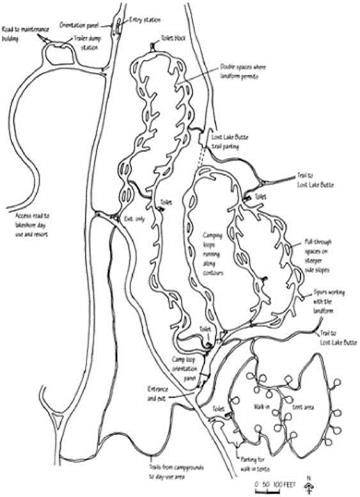 |
The new layout at Lost Lake
Campground showing the various camping loops, linkages with the lake and trails, and the strategic siting of toilet provision.
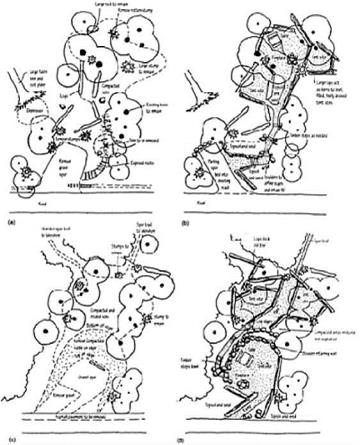 |
Spur designs at Lost Lake
Campground: (a) A typical spur before redesign, badly worn and ill defined. (b) The new spur above the road with the tent sites set above, surfacing bounded by logs and accessed by a short trail. Some areas have been restored to native vegetation. (c) A downhill spur before redesign, dominated by the compacted rubble used to build up the parking. (d) The new design removes the parking in favour of a walk-
in spur, and provides several tent sites suitable for group use dispersed on two levels. Rocks are used to retain the slope, and logs provide edgings.
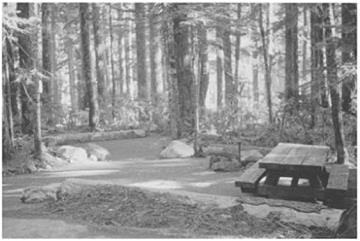 |
One of the redesigned sites at Lost
Lake Campground, showing how the detailed aspects fit the site well. (Courtesy Dean Apostol)
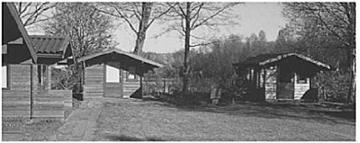 |
A site containing several small timber cabins set around an open area. This is a high-density layout, which some people find acceptable. Amsterdamse Bos, Holland.
If a single cabin is considered then the task is easier, The The more primitive cabins with no electricity, with a composting toilet and water
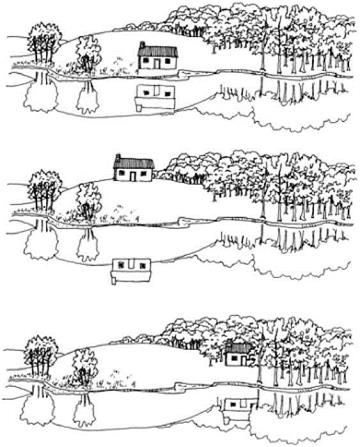 |
Siting of a single cabin: (a) Shows the cabin near the water’s edge, where it dominates the open space. (b) Shows how siting on the skyline creates a very focal view. (c) Shows an example set into the edge of trees so that it is much less intrusive, and does not dominate the landscape.
obtained from a well, spring, river or lake can offer a very significant contrast with the modern world. The location may depend on foot or boat access, and so a position should be chosen that makes use of the local terrain for shelter, sunshine, nearness to water and the access point while avoiding sensitive vegetation, or site excavation. This may entail a detailed search within the possible area. Local materials together with some that are brought in can be used to construct a cabin that should appear to be part of the landscape.
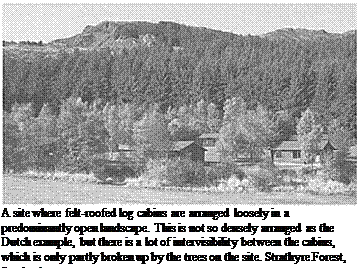 |
Many people’s weekend cabins are likely to be more sophisticated. Running water is probably needed. Vehicle access will be desirable for the delivery of equipment and stores as well as for emergency access if the location is an area of fire risk in dry conditions. All this implies a more developed site. Extensive use should be made of natural terrain
and vegetation to screen and blend the cabin into the landscape. In most cases, a cabin position either parallel or at right angles to the contour or landform will provide a satisfactory visual relationship. In damper climates the cabin can be set amongst trees that are thinned to let light in but are kept close to the walls. In drier climates a more open area is desirable to reduce the risk of fire.
If flush toilets are required the location of sites for septic tanks needs to be identified (see Chapter 6) This may limit the choice of sites within the area.
Frequently people want to build their cabin close to a lake or the sea shore. Shoreline vegetation, especially on sand-dunes, tends to be extremely fragile, so that cabin construction, access tracks and disturbance of slow-colonizing plants can have a serious impact on the whole area. Sites should be chosen where the surrounding vegetation is robust and where the ground conditions are less likely to erode.



